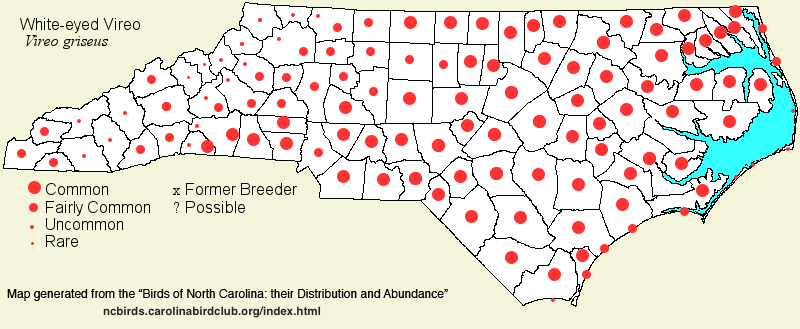 |  |
|
White-eyed Vireo - Vireo griseus VIREONIDAE Members: | Search Common: Search Scientific: |
|
|
|||||||
| General Comments | The White-eyed Vireo breeds over the southeastern part of the United States, and it winters in parts of the Coastal Plain of this range. Though it can be somewhat hard to see without a tape, it is common over much or most of the state, but much less so in the mountains. Owing to milder winters in the past few decades, the species is being seen much more frequently on CBC's along and near the coast. In 1970 or 1980, this would have been a "boldfaced" bird on any count in the state, but nowadays many counts near the coast expect to have a few found. The species nests in thickets and other dense cover, usually where damp; habitats include thickets around a lake or pond shore, openings such as road margins through a bottomland or swamp, and regenerating clearcuts. In winter, it favors dense evergreen cover, so there is some change of habitat from the summer season (where the habitat might be mostly deciduous vegetation); maritime forests and thickets, and bottomlands with privet or holly species are favored places. At all times, it is usually found in the shade of dense cover, seldom more than 25 feet from the ground; it is our only breeding species of vireo that favors shrub and understory layers. | ||||||
| Breeding Status | Breeder | ||||||
| NC BRC List | Definitive | ||||||
| State Status | |||||||
| U.S. Status | |||||||
| State Rank | S5B,S1N | ||||||
| Global Rank | G5 | ||||||
| Coastal Plain | Summer resident throughout, and scarce winter resident near the coast. In summer, common essentially throughout, even on barrier islands. In winter, uncommon (and somewhat secretive) along and near the southern coast (Carteret southward), and rare to uncommon northward and in Tidewater. Rare farther inland, and likely does not overwinter there. Even near the coast and Tidewater, many birds on CBC's probably do not survive the winter. Inland, mainly mid- or late Mar to mid-Oct. Peak counts: | ||||||
| Piedmont | Summer resident, with some migratory movements; strays into early winter. In the breeding season, common in the eastern and southern portions, to fairly common farther northward and westward. A number of winter records (at least 13 records from Dec to Feb). Most unusual, so far inland in winter, was one photographed at Pilot Mountain SP (Surry) on 21 Dec 2023. Mainly late Mar to early Oct. Peak counts: | ||||||
| Mountains | Summer resident. Fairly common in lower elevations (below 2,500 feet), and uncommon to about 4,000 feet. Generally absent as a breeder above about 4,000 feet. Some post-breeding birds move to higher elevations. Primarily early or mid-Apr to early Oct. The only winter report was one found on the Henderson CBC, 1 Jan 2012 [Chat 76:61 link]. Peak counts: | ||||||
| Finding Tips |
A morning of birding in most parks, refuges, and other preserves in the Coastal Plain will yield the species, though they can be hard to see well without a tape; they do respond to pishing. A few should be found on most Piedmont mornings of birding, though they are somewhat easier to find in the Coastal Plain. **** | ||||||
| Attribution | LeGrand[2025-05-09], LeGrand[2024-05-14], LeGrand[2023-03-24] | ||||||
| NC Map Map depicts all counties with a report (transient or resident) for the species. | Click on county for list of all known species. |
| NC Breeding Season Map Map depicts assumed breeding season abundance for the species. |  |